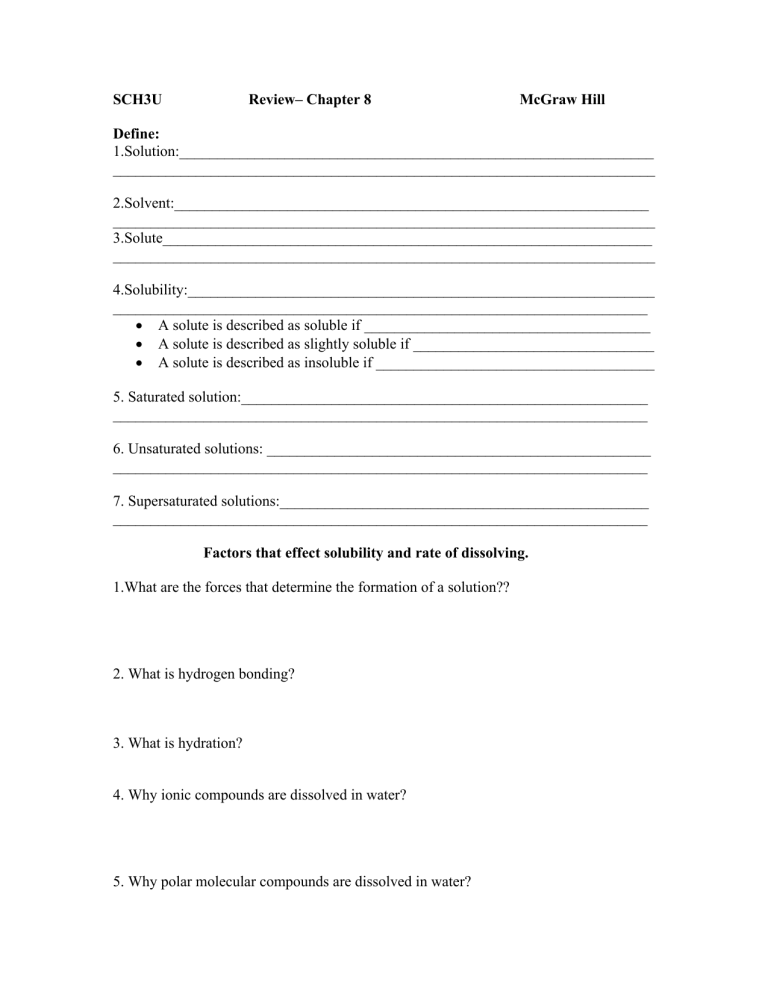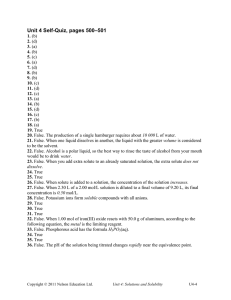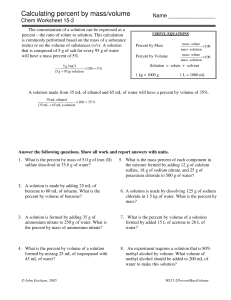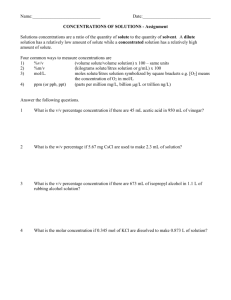
SCH3U Review– Chapter 8 McGraw Hill Define: 1.Solution:_______________________________________________________________ ________________________________________________________________________ 2.Solvent:_______________________________________________________________ ________________________________________________________________________ 3.Solute_________________________________________________________________ ________________________________________________________________________ 4.Solubility:______________________________________________________________ _______________________________________________________________________ A solute is described as soluble if ______________________________________ A solute is described as slightly soluble if ________________________________ A solute is described as insoluble if _____________________________________ 5. Saturated solution:______________________________________________________ _______________________________________________________________________ 6. Unsaturated solutions: ___________________________________________________ _______________________________________________________________________ 7. Supersaturated solutions:_________________________________________________ _______________________________________________________________________ Factors that effect solubility and rate of dissolving. 1.What are the forces that determine the formation of a solution?? 2. What is hydrogen bonding? 3. What is hydration? 4. Why ionic compounds are dissolved in water? 5. Why polar molecular compounds are dissolved in water? 6. Why non-polar molecular compound are not dissolved in water? 10. “Like Dissolve Like”. Complete the chart. Polar or Ionic Solvent Solute Non-polar Polar Non-polar 11. Does CH3OH dissolves in PH3 gas? Explain. 12. A solution of NaCl is produced by dissolving 2g of the substance in 100mL of water. Sodium chloride is classified as: a. soluble b. slightly soluble c. insoluble Answer: A 13. A solution of NaCl is classified as a saturated solution at room temperature. If a spoon of solute is added to the solution, it decants at the bottom of the container. Is the final solution consider a supersaturated solution? ______NO _________________ 14. Explain why stainless steel, seawater, and air are all considered solutions. They are mixtures. They are homogenous. 15. Which solution will contain the higher concentration of nitrate ions? (Answer: b) 0.452 mol/L sodium nitrate or 0.228 mol/L aluminum nitrate a. sodium nitrate b. aluminum nitrate c. They contain the same concentration of nitrate ions. d. This must be determined experimentally. 16. Which of the following is a liquid in gas type of solution? (answer: B) a. carbon dioxide in water b. water in air c. methanol in water d. oil in water 17. Which of the following does not dissolve very well in water? (answer : D) a. sodium chloride b. sugar c. ethanol d. gasoline 18. A solution that has a relatively large quantity of solute dissolved in the solvent is (Answer: C) a. homogenous b. dilute c. concentrated d. saturated 19. Which of the following contains 1 mol of dissolved copper(II) nitrate? (Answer: C) a. 500 mL of a 0.5 mol/L solution b. 750 mL of a 0.75 mol/L solution c. 500 mL of a 2.0 mol/L solution d. 1 L of a 0.9 mol/L solution 20. Which piece of lab equipment is used to obtain a small, accurate volume from a stock solution for a dilution procedure? (answer: B) a. graduated cylinder b. pipet c. beaker d. volumetric flask 21. In a chemical analysis, 2.2 mg of oxygen was measured in 250 mL of pond water. What is the concentration of oxygen, in ppm? mO2 = 2.2mg vH2O=250ml=0.25L cO2=? mO2 2.2mg C = ------------ = ------------ = 8.8 ppm vH2O 0.25L




